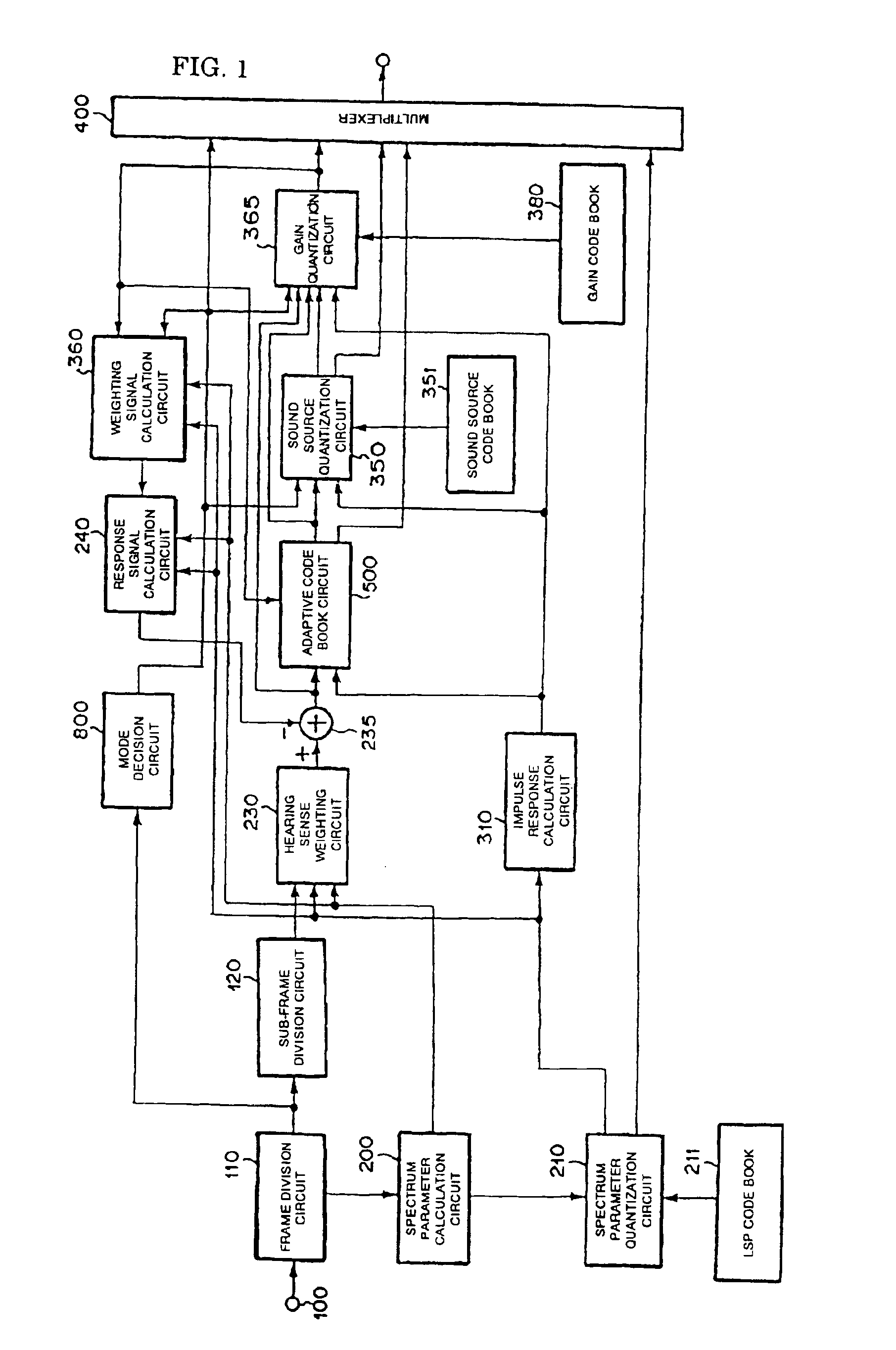Voice encoding/decoding device
a voice coding and decoding technology, applied in the field of voice coding/decoding apparatus, can solve the problems of insufficient number of pulses, disadvantageous disadvantageous amount of operation, and enormous amount of operation
- Summary
- Abstract
- Description
- Claims
- Application Information
AI Technical Summary
Problems solved by technology
Method used
Image
Examples
first embodiment
(First Embodiment)
FIG. 1 is a block diagram of a voice coding apparatus according to the present invention. In FIG. 1, a voice signal is input from an input terminal 100, and the voice signal is divided by a frame division circuit 110 every frame (for example, 20 mS). In a sub-frame division circuit 120, the voice signal of the frame is divided into sub-frames each of which is shorter than the frame (for example, 5 mS).
In a spectrum parameter calculation circuit 200, a windows which is longer than a sub-frame length (for example, 24 mS) is applied to the voice signal of at least one sub-frame to cut a voice, and the spectrum parameter is raised to the power of a predetermined number (for example, P=10th). In the calculation of the spectrum parameter, the known LPC analysis, a BURG analysis, and the like can be used. In this case, it is assumed that the BURG analysis is used. The details of the Burg analysis are described in “Signal Analysis and System Identification” by Nakamizo (pp...
second embodiment
(Second Embodiment)
FIG. 19 is a block diagram of another coding apparatus according to the present invention. Since constituent elements in FIG. 19 to which the same reference numerals as in FIG. 1 are added perform the same operations as in FIG. 1, a description thereof will be omitted. In FIG. 19, the operation of a sound source quantization circuit 355 is different from that of FIG. 1. In this case, when mode decision information is Mode 0, a position generated according to a predetermined rule is used as a position of a pulse.
For example, the positions of pulses the number of which are predetermined (for example, M1) are generated by a random number generation circuit 600. More specifically, M1 numeral values generated by the random number generator are considered as the positions of pulses. In addition, the plural sets of positions of different types are generated. The M1 positions of the plural sets generated as described above are output to the sound source quantization circu...
third embodiment
(Third Embodiment)
FIG. 21 is a block diagram of a decoding apparatus according to the present invention. This decoding apparatus may be combined to the coding apparatus shown in FIG. 1 to form a coding / decoding apparatus. In FIG. 21, a demultiplexer 500 receives mode decision information, an index representing a gain code vector, an index representing delay of an adaptive code book, information of a sound source signal, an index of a sound source code vector, and an index of a spectrum parameter from a received signal, and separately outputs the respective parameters.
A gain decoding circuit 510 receives the index of the gain code vector and the mode decision information, and reads and outputs a gain code vector from the gain code book 380 depending on the index.
An adaptive code book circuit 520 receives the mode decision information and the delay of the adaptive code book, generates an adaptive code vector, and multiples the gain code vector by the gain of the adaptive code book to ...
PUM
 Login to View More
Login to View More Abstract
Description
Claims
Application Information
 Login to View More
Login to View More - R&D
- Intellectual Property
- Life Sciences
- Materials
- Tech Scout
- Unparalleled Data Quality
- Higher Quality Content
- 60% Fewer Hallucinations
Browse by: Latest US Patents, China's latest patents, Technical Efficacy Thesaurus, Application Domain, Technology Topic, Popular Technical Reports.
© 2025 PatSnap. All rights reserved.Legal|Privacy policy|Modern Slavery Act Transparency Statement|Sitemap|About US| Contact US: help@patsnap.com



